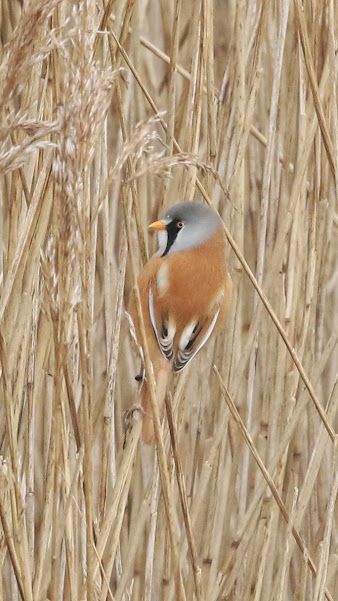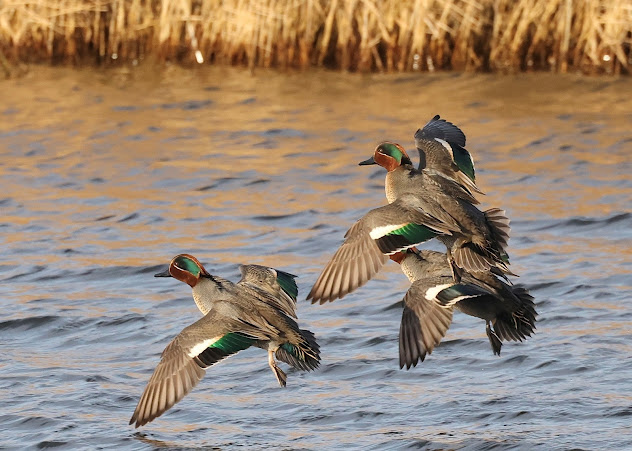Shorelarks - Request to birders looking for these birds; access to the favoured site (around wins.degree.simulator)is along the beach south from Seacroft. Parking at Drake Road/Seacroft Esplanade. Please avoid the Greenshank's Creek area to the south which is an important part of the Special Protection Area (SPA) for feeding and roosting waders.
January 31st. A single Waxwing flew south. Other birds around included 48 Whooper Swans, 2 Hen Harriers, a Peregrine and a Red Kite.
January 30th. The Smew was seen again on Tennyson's Sands and 2000 Pink-footed Geese arrived during the late afternoon and landed on Croftmarsh.
January 29th. Another bright morning, mild, with a cool southerly breeze. The Whooper Swans departed their roost at 0745 and the 2 Bearded Tits were in the adjacent reedbed on Tennyson's Sands. At least 6000 mixed waders came up to roost on the high tide. Snow Bunting had increased to 23 along the north end beach with the 4 Shorelarks nearby. good numbers of Skylark and Linnet were also along the frontal dunes and marshes with a single Lapland Bunting calling in flight when passerines were flushed by a hunting Merlin. 2 Waxwings were along the Cycletrack. Late in the day, the redhead Smew was seen again on Tennyson's Sands. Other birds around included 5 Woodcocks.
January 28th. A bright morning, fairly mild with a stiff southerly breeze. A good morning for Geese, with 500 Pink-footed Geese leaving the roost early morning and a further 600 south offshore into the wash. Another skein of 70 contained Barnacle Goose and then a group of 5 adult White-fronted Geese arrived from the north and continued south. Another good day for birds of prey too with 3 Buzzard, 2 Marsh harrier, a male Hen Harrier and a Barn Owl. At one time, 2 Peregrines were attacking a Marsh Harrier and a Buzzard over Croftmarsh. A single Waxwing was reported and 51 Whooper Swans were again at roost.
January 27th. A return to colder conditions with a morning frost and a westerly breeze. 3 Waxwings flew south early. A morning seawatch was productive with 2 Velvet Scoter, a Goldeneye, 5 Red-breasted Merganser, a Kittiwake, a Med Gull, 70 Red-throated Diver and a Black-throated Diver heading south, a Great Northern Diver moving north and the 3 Long-tailed Ducks close in. A light southerly passage of Finches and Skylarks was also noted over the East Dunes and beach with 30 Siskins on the move and a further 11 Siskins around the North Car Park. The 2 Bearded Tits were seen again on Tennyson's sands and 51 Whooper wans came in to roost. Other birds around included 2 Water Pipits, 2 Merlin and a Bullfinch.
January 26th. A much improved day with bright sunshine and good visibility. Little change offshore and along the beach with the 3 Long-tailed Duck and 4 Shorelark still present but a southbound Lapland Bunting was a first for the year. The rarest birds of the day though were 2 Raven that arrived form the south and headed out north-east. 53 Whoopers came in to roost. It was also very interesting to note that a Goldcrest that arrived here and was ringed on 31st October last year has overwintered in the Plantation and not moved on despite several periods of cold weather. Well done to the team who were able to determine the ring number from photographs !.
January 25th. Quite mild and dull before drizzle from mid morning. No sign of yesterdays Smew, but 5 waxwings were new in by North Car Park early morning before heading north. Along the beach and outer ridges, still 4 Shorelark, 8 Snow Bunting and at least 1 Twite with the flock of around 100 Linnets. 2 Bearded Tit were seen on Tennyson's Sands late afternoon nd 51 Whooper Swans came in to roost.
January 24th. Overcast again but milder and dry. The Whoopers left their roost site at dawn but there were plenty of Wigeon, Teal and Shoveler on the lagoons - having returned after the freeze. A new arrival was a superb redhead Smew, initially on Jackson's Marsh before moving to Tennyson's Sands. Very much a Gib rarity this was the first since 2013 and much appreciated by the local birders. Elsewhere, a delayed seawatch resulted in a southbound Barnacle Goose, a Red Kite was around and a Chiffchaff was at Sykes Farm.
January 23rd. Overcast initially with a strong and cold westerly breeze, then rain from mid-morning. A 45 minute sea-watch produced 55 Red-throated Divers, 250 Eider, 10 Red-breasted Merganser and 8 Great Crested Grebe, with the highlights being a Velvet Scoter south and the 3 Long-tailed Ducks close in. At least 1 Snow Bunting was still around the beach. 5 Woodcocks were seen in the dunes and 49 Whooper Swans came in to roost.
Ringing Recovery: Lesser Redpoll, ringed GPBO 29 October 2023, found dead Crich, Derbyshire 19 January 2024.
January 22nd. Fairly mild but with a cool south-westerly breeze after the overnight gale from Storm Isha. A Waxwing was along the Cycle Track early morning, a Red Kite flew south early morning plus another three south later and 8 Snow Bunting were around the beach. Good numbers of Eider were on the sand bars again at low tide, with the 3 Long-tailed Duck on the sea. A flock of around 100 Linnets contained at least 1 Twite. Some displaced waders were in evidence after the storm with 2 Grey Plover and a Ringed Plover feeding with the Black-tailed Godwits on Croftmarsh. Nearby, 44 Whooper Swans came in to roost on Tennyson's Sands and 3 Water Pipits were around the Freshwater Marsh.
January 21st. Milder conditions. Around 800 Eider were on the sand bars at low tide with single Red-necked Grebe and Goldeneye south offshore. The 3 Long-tailed Ducks were on the sea with a good count of 22 Great Crested Grebes. 8 Snow Buntings were along the beach. Other birds around included 5 Marsh Harrier, a Woodcock and a Barn Owl.

























.jpg)
















